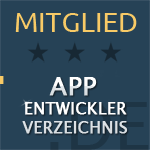
Insight

Insight

Insight
Documentation through tests: Successfully implementing acceptance tests in Flutter apps


Julian Giesen
·
·
Monday, March 18, 2024


Julian Giesen
Often, the documentation of a Flutter app is not up to date or is neglected. One way of documenting is through acceptance tests. They are there to find bugs and serve as living documentation. Acceptance tests are a powerful tool in Flutter apps for documenting functionalities and requirements.
Good documentation through tests not only provides clarity about the expected functionality of an app but also improves collaboration between developers, project managers, and clients. By using natural language in tests, especially with the Gherkin syntax, communication is facilitated and misunderstandings are minimized. The ultimate goal of acceptance tests in Flutter apps is to provide clear and consistent documentation that not only reflects the current state of the app but also serves as a reference for future developments.
What are acceptance tests?
Acceptance tests are a form of automated tests designed to ensure that an application meets the requirements defined by the user. They simulate typical user interactions and check whether the application works according to the specifications. In the context of Flutter apps, acceptance tests are used to ensure that the UI elements function correctly and that the application meets the users' requirements and expectations.
In contrast to unit tests, which are conducted at the code level, acceptance tests test the application at a higher level. They focus on the end-to-end functionality of the application and interact with the user interface to ensure that all components work together properly. In Flutter, widget tests are particularly well-suited to describe acceptance tests at the code level.
The use of acceptance tests offers several advantages. On the one hand, they provide comprehensive verification of the application from the user's perspective, leading to higher quality and reliability. Furthermore, they serve as living documentation of the application requirements and functionalities, improving collaboration between developers, project managers, and clients. Automating acceptance tests can also save time and resources, as they can be executed repeatedly and efficiently without the need for tedious manual testing of the app.
Overall, acceptance tests play a crucial role in the development process of Flutter apps by ensuring that the application meets requirements and provides a positive user experience.
Gherkin: The language of acceptance tests
Gherkin is an easily understandable tool that is commonly used for defining acceptance tests. It is based on a simple set of keywords in natural language that allow for clear and structured descriptions of test scenarios. Gherkin is designed to be easily readable by all involved, including developers, project managers, and clients.
The use of Gherkin offers several advantages for creating acceptance tests. For one, it facilitates better collaboration among the various stakeholders since the tests are written in a language that everyone can understand. Gherkin also promotes clear and consistent documentation of application requirements, as test scenarios are recorded in a structured and easily traceable form.
Examples of Gherkin syntax in Flutter apps
With the Gherkin syntax, the requirements of an app are described as features. It makes sense to first break down the requirements into user stories. The user stories can then be described as scenarios using Gherkin. The documentation of a scenario follows the pattern of the following instructions: Given, When, Then and can be supplemented in each step with And instructions.
Here is an example of using the Gherkin syntax:
Feature: Description of the feature being tested.
Background: Description of the conditions that apply to all scenarios in the feature.
Scenario: Description of a specific scenario that is to be tested.
Steps: Description of the steps required to execute the scenario.
Feature: Chat Overview
Background:
Given I am on the chat overview page
Scenario: Show chat overview with no chats
Given I am logged in
When I have no chats
Then I should see the chat overview page
And I should see no chats
Scenario: Show chat overview with chats
Given I am logged in
When I have chats
Then I should see the chat overview page
And I should see my chatsGherkin Example 1
Implementing acceptance tests in Flutter
bdd_widget_test is a package for testing Flutter apps, especially for conducting acceptance tests. It is based on the Behavior-Driven Development (BDD) approach and offers an intuitive syntax for describing test scenarios with Gherkin.
Installation is simple and straightforward. Just add the following dependency to the pubspec.yaml file:
dev_dependencies:
bdd_widget_test: ^latest_versionThen run flutter pub get to download and set up the package. After installation, the package can be used in your tests.
The package can be used for a variety of use cases in Flutter apps, including:
Checking the user interface and interactions
Validating business logic and functionalities
Integration tests for complex scenarios and workflows
The practical application of bdd_widget_test in Flutter apps enables effective and comprehensive verification of application requirements and functionalities. Additionally, using natural language in test scenarios improves app documentation and ensures clear communication between teams.
To create an acceptance test, we can create the Gherkin Example 1 .feature file chat_overview.feature and have the Flutter test code generated for it, with:
dart run build_runner buildHere is an example of how the generated code may look:
void main() {
group('''Chat Overview''', () {
Future<void> bddSetUp(WidgetTester tester) async {
await iAmOnTheChatOverviewPage(tester);
}
testWidgets('''Show chat overview with no chats''', (tester) async {
await bddSetUp(tester);
await iAmLoggedIn(tester);
await iHaveNoChats(tester);
await iShouldSeeTheChatOverviewPage(tester);
await iShouldSeeNoChats(tester);
});
testWidgets('''Show chat overview with chats''', (tester) async {
await bddSetUp(tester);
await iAmLoggedIn(tester);
await iHaveChats(tester);
await iShouldSeeTheChatOverviewPage(tester);
await iShouldSeeMyChats(tester);
});
});
}For each individual function within the testWidgets() scenarios, a separate file is created in the step folder where the widget tests are implemented.
For iShouldSeeNoChats, it may look like this:
/// Usage: I should see no chats
Future<void> iShouldSeeNoChats(WidgetTester tester) async {
expect(find.byType(ChatRoomItem), findsNothing);
}By using bdd_widget_test, we can easily transform Gherkin scenarios into widget tests, ensuring that our Flutter apps meet the requirements and function correctly.
My workflow for creating acceptance tests
Step-by-step to create acceptance tests:
Requirements analysis: First, I analyze the app's requirements to understand which features need to be tested.
Defining test scenarios: Based on the requirements, I define clear and understandable test scenarios in Gherkin.
Setting up the tests: I set up a separate testing area where acceptance tests can be executed. This allows for a clean separation of production and test code.
Implementing the tests: Using the
bdd_widget_testpackage, I implement the defined test scenarios as widget tests.Executing the tests: I run the created acceptance tests to ensure that the application functions according to the specifications.
Best practices for effective acceptance tests in Flutter:
Clear description: I describe the test scenarios clearly and precisely to avoid misunderstandings.
Modularity: I structure my tests modularly to allow for easy maintenance and extension.
Reusability: I ensure to write test code that is reusable to avoid redundancy.
Regular updates: I keep my tests regularly updated to ensure they reflect the current state of the app.
Integrating acceptance tests into the development process:
Early integration: I integrate acceptance tests early into the development process to receive feedback early and identify potential issues.
Automated execution: I automate the execution of my acceptance tests to ensure that they are performed regularly and reliably.
Feedback loop: I use the feedback from acceptance tests to make improvements to the code and continuously enhance the quality of the app.
With this workflow, I can effectively and efficiently create acceptance tests for Flutter apps and ensure that they serve not only as documentation but also improve the quality and reliability of the application.
Summary
Acceptance tests are written in Gherkin syntax to make them easily understandable and maintainable. These tests serve not only as documentation but also as effective means to verify the functionality and quality of Flutter apps.
The importance of acceptance tests will continue to grow in the future, as they play a crucial role in ensuring the quality and user-friendliness of apps. With the continuous development of Flutter and corresponding packages like bdd_widget_test, we will have even more powerful tools available to make acceptance tests more efficient and seamlessly integrate them into the development process.
It is important for developers and teams to view the implementation of acceptance tests as an integral part of their development process. By continuously integrating acceptance tests, we can improve the quality of our apps, reduce development time, and ultimately provide a better user experience. Therefore, it is advisable to continue familiarizing oneself with best practices and tools for creating and executing acceptance tests and actively incorporating them into development.
Ready to enhance the quality of your Flutter app? As an experienced Flutter developer focused on integrating acceptance tests, I am here to support your project and show you how to maximize documentation through tests using bdd_widget_test. Let's take your app to the next level together!
All insights
All insights
“Flutter and the related logo are trademarks of Google LLC. We are not endorsed by or affiliated with Google LLC.”
“Flutter and the related logo are trademarks of Google LLC. We are not endorsed by or affiliated with Google LLC.”
Copyright ©2025. Julian Giesen. All rights reserved.
“Flutter and the related logo are trademarks of Google LLC. We are not endorsed by or affiliated with Google LLC.”






